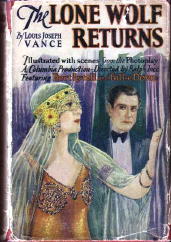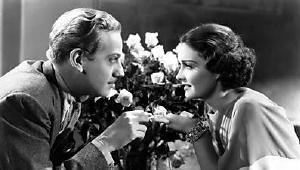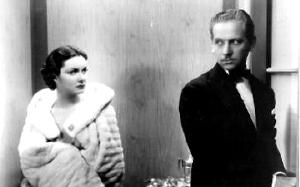Sun 27 Jul 2008
THE LONE WOLF RETURNS. Columbia, 1935. Melvyn Douglas, Gail Patrick, Tala Birell, Henry Mollison, Thurston Hall, Raymond Walburn, Douglass Dumbrille. Based on the novel by Louis Joseph Vance (Dutton, 1923). Directed by Roy William Neill.

I included some background on “The Lone Wolf” as a character in this earlier post, so I won’t repeat it here. Suffice it to say that I’ve watched the two movies in the wrong order, since The Lone Wolf in Paris, the previously reviewed film, came out three years later, and starred Francis Lederer, not Melvyn Douglas, as Michael Lanyard, the notorious jewel thief.
Not that there’s any sense of continuity between the two films, as enjoyable as each of them happens to be. I don’t imagine it will spoil anything to say that at the end of The Lone Wolf Returns wedding bells seem to be in the offing, while I don’t remember anything of the sort being referred to in The Lone Wolf in Paris.
As it happens, I think that Melvyn Douglas was perfect for the part: suave, debonair, and just the kind of man who would rob wall safes in a top hat and tails. He’s in New York City in this one, or Michael Lanyard is, and not his usual European stomping ground

And when he meets beautiful society girl Marcia Stewart, played by beautiful Gail Patrick, he decides at once that that’s it, his days of criminal activity are over, much to the consternation of Jenkins, his devoted valet and primary assistant in thievery, played to great comedic effect by Raymond Walburn.
Gail Patrick, by the way, dropped out of movie roles in the late 1940s, only to become the executive producer for (I think) the entire run of the Raymond Burr “Perry Mason” television series in the mid-1950s.

Getting back to the Lone Wolf, though, another gang of jewel robbers is not pleased to see Lanyard anywhere in the vicinity of their next job – and you get only one guess as to whose emeralds they plan to steal – and implicating him for the theft fits very nicely into their plans.
If you can ignore the funny stuff – other than the top man in command, most cops that you find in 1930s mystery movies are funny, and so are the underling henchmen, always – I think you will find this movie as entertaining as I did. (And even some of the funny stuff is funny.)
There was an earlier version of the movie, a 1926 silent film also based on the book by Louis Joseph Vance, and starring Bert Lytell and Billie Dove in the two leading roles. You can make out their likenesses on the cover of the book shown above, a Grosset & Dunlap photoplay edition.